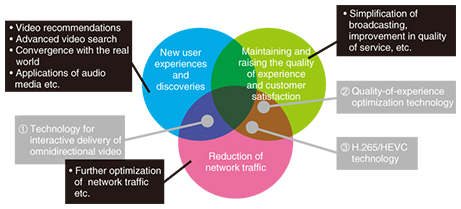 |
|||||||||||||
|
|
|||||||||||||
|
Feature Articles: Dwango × NTT R&D Collaboration Vol. 13, No. 6, pp. 6–10, June 2015. https://doi.org/10.53829/ntr201506fa1 Overview of Dwango × NTT R&D CollaborationAbstractNearly two years have passed since Dwango Co., Ltd. and NTT signed a business collaboration agreement to enhance video and social services in July 2013. This collaboration between Japan’s largest video streaming service provider and a telecommunication carrier is an endeavor to explore solutions to issues commonly faced by the two companies, such as those related to networking, and it has begun to yield a number of noteworthy results. This article presents the objectives and the scope of this business collaboration and describes some of the results. Keywords: collaboration, video and social service, network efficiency 1. IntroductionDwango Co., Ltd. and NTT concluded a business collaboration agreement regarding research and development (R&D) on enhancing video and social services in July 2013 [1, 2]. As a leading and comprehensive R&D organization in the ICT (information and communication technology) field, NTT laboratories undertake a wide range of R&D from innovative communication services to next-generation information network infrastructure technologies and leading-edge basic research on new principles and components. From a different perspective, Dwango, Japan’s representative video streaming service provider, provides unparalleled, out-of-the-box services such as Niconico (Niconico video and Niconico Live) and nicofarre. It thus handles an extremely large volume of traffic. The objective of the collaboration is to create a win-win relation between the two companies by bringing together the strengths of each party in collaborative research and experiments. Specifically, Dwango aims to evolve and enhance their services by using NTT’s leading-edge technologies, while NTT intends to broaden the scope of the application of its R&D capabilities and enhance its technical expertise by incorporating feedback from the collaborative endeavor. The collaboration is expected to bring about further development of service and networking technologies in the promising field of video and social services. 2. Scope of the business collaborationThis business collaboration involves collaborative research and experiments focusing on three fields: networks, media user interface (UI)/user experience (UX), and big data (Fig. 1).
(1) Networks Since video and social services are expected to expand in the years to come, we are studying efficient ways of using networks while at the same time raising customer satisfaction. As the first stage, a collaborative experiment is being carried out to study quality of service based on actual user experience and globally optimized control of networks, terminals, and applications. This experiment is backed by NTT laboratories’ technologies and know-how in assessing the quality of network/communication services. (2) Media UI/UX We are studying the most appealing and efficient use of a variety of media that arise from Dwango’s unique creations such as Niconico and its unique communication culture. Specifically, we are aiming to achieve efficient delivery of 360-degree video, efficient video coding, innovative video search, and the automatic conversion of audio presentations into text. (3) Big data With the explosive increase in the number of items of video content and the number of their users in recent years, it is important to raise customer satisfaction by providing recommendations for video content suitable for individual users. Technologies for collecting and analyzing a large volume of log data will play a major role in creating recommendations. Currently, we are investigating ways to enhance existing content recommendation technology used in Dwango based on distributed processing technology such as Jubatus, which is a framework for large-scale distributed real-time analysis, and machine learning technology developed by NTT laboratories. Activities in these fields have enabled Dwango engineers, who are characterized by a freewheeling sense of value and judgment, speedy action, and extensive expertise, and NTT researchers, who are exploring leading-edge technologies, to stimulate each other and achieve synergy. The collaboration is being expanded to embrace non-technical areas, for example, exchanges of human resources and hosting of events such as Niconico Chokaigi. 3. Results of the business collaborationThe activities undertaken since the implementation of the business collaboration agreement have yielded a variety of results, as summarized below. These results have enabled the two companies to achieve their initial objectives: enabling Dwango to upgrade its services and NTT to enhance its technologies. On top of that, the results will greatly contribute to both companies’ meeting the challenges they mutually face. It has been customary to consider the relationship between OTT (Over the Top) companies such as Dwango and telecommunication carriers such as NTT as one characterized by a conflict of interest. However, this collaboration has shed a new light on the relationship. It has fostered an expectation that the two parties can collaborate to achieve their respective objectives, namely, enabling Dwango to raise customer satisfaction by enhancing services, and NTT to improve the efficiency of network utilization (Fig. 2).
The featured articles that follow introduce specific results that will strengthen this new collaborative relationship (Fig. 3). The first article, “Real-time Omnidirectional Video Streaming System,” introduces technology for the interactive delivery of omnidirectional video [3]. This technology enables the user to view a video that is sent from a 360-degree omnidirectional camera installed at a live event site, in any direction he/she wants by using a head-mounted display such as Oculus Rift. This technology provides an innovative user experience while reducing the volume of traffic by selectively delivering at high quality only the video of the direction in which the user is viewing. This technology has been commercially introduced in the virtual reality live delivery service provided by Dwango. On November 17, 2014, a performance by the singer Sachiko Kobayashi at Nippon Budokan was streamed in Niconico Live as part of this service.
Technology that optimizes quality of experience (QoE) is introduced in the second article, “Quality of Experience Optimization Technology (Quality API).” This technology reduces the volume of traffic in the network by controlling the individual user’s traffic to suit his/her viewing environment while still maintaining the user’s viewing satisfaction [4]. It was confirmed in a small-scale evaluation experiment that the frequency of users selecting “Pause” decreased dramatically, indicating an improvement in QoE. The experiment was expanded in November 2014 to cover all Niconico users. H.265/MPEG-H, also known as HEVC (High Efficiency Video Coding) technology introduced in the last article, “Collaborative Trial: Application of HEVC Technology to Niconico Live [5],” is the next-generation video encoding standard, which boasts a higher compression ratio than the conventional standard, H.264/MPEG-4 (Moving Picture Experts Group, version 4) AVC (Advanced Video Coding). Because this compression processing requires an enormous amount of computation, it has been challenging to achieve compression in real time. NTT’s technology has made this a reality. Currently, a collaborative experiment is being carried out with a view to applying the technology to Niconico Live. In addition to the technologies introduced above, NTT has provided speech recognition technology that was used in the “Denou-sen Revenge Match,” a match of the Japanese game of shogi. Held on the last day of 2014, this match between the ninth-dan-level Taku Morishita and Tsutsukana, a shogi software program, attracted widespread attention. Sotto voce* remarks muttered by Morishita while he was considering the next step were automatically recognized, proofread as necessary, and displayed on the screen as comments. In social networking services, there were favorable comments as to the high accuracy of speech recognition, and the appreciation of this unique service of displaying muttered remarks (Fig. 4).
4. Future prospectsAlthough Dwango and NTT have completely different corporate cultures, we consider that the combination of Dwango’s capabilities to create, develop, provide, and operate something new and enjoyable and NTT’s leading-edge R&D capabilities can achieve a wide range of synergy. Looking forward, we will broaden the scope of collaboration, including effective recommendations for video, new search technology and further enhancement of quality of service, in order to develop innovative services and networks (Fig. 5).
References
|
|||||||||||||

















